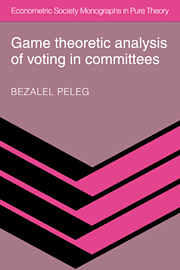Book contents
- Frontmatter
- Background and Motivation
- 1 Introduction and Summary of the Main Results
- 2 Preliminary Concepts and Basic Results
- 3 Representations of Committees
- 4 Strong and Dynamic Representations
- 5 Exactly and Strongly Consistent Anonymous Social Choice Functions
- 6 Effectivity Functions and Implementation
- 7 Concluding Remarks
- References
- Author Index
- Subject index
Background and Motivation
Published online by Cambridge University Press: 05 January 2013
- Frontmatter
- Background and Motivation
- 1 Introduction and Summary of the Main Results
- 2 Preliminary Concepts and Basic Results
- 3 Representations of Committees
- 4 Strong and Dynamic Representations
- 5 Exactly and Strongly Consistent Anonymous Social Choice Functions
- 6 Effectivity Functions and Implementation
- 7 Concluding Remarks
- References
- Author Index
- Subject index
Summary
The theory of voting in committees began with the basic contributions of Borda [1781] and Condorcet [1785]. Borda had been concerned about the inadequacy of choice by plurality voting, and he suggested a different method of assigning marks to alternatives, a method now known as Borda's rule (see Black [1958], pp. 156-9). It is interesting that Borda's method is still a subject of active research (see, e.g., Young [1974] and Gardner [1977]). Indeed, Borda's rule also serves as an important example in this book (see Example 3.1.18).
Condorcet developed an extensive formal theory of voting (see Black [1958], pp. 159-80). One of his profound discoveries was the “paradox of voting,” which is known also as Condorcet's paradox. His most important contribution was the formulation of the Condorcet condition (i.e., the alternative that receives a majority, against each of the other alternatives, should be chosen). This condition plays an important role in so many works in modern social choice theory that it is impossible to give a full record of its use. We, also, apply the Condorcet condition to the theory of committees (see, e.g., Theorem 3.2.5).
Nanson [1882] examined several systems of voting and suggested a modification of Borda's rule that is compatible with the Condorcet condition. (Borda's rule itself does not satisfy the Condorcet condition). Further details on Nanson's work may be found in Black [1958].
Information
- Type
- Chapter
- Information
- Game Theoretic Analysis of Voting in Committees , pp. 1 - 7Publisher: Cambridge University PressPrint publication year: 1984
